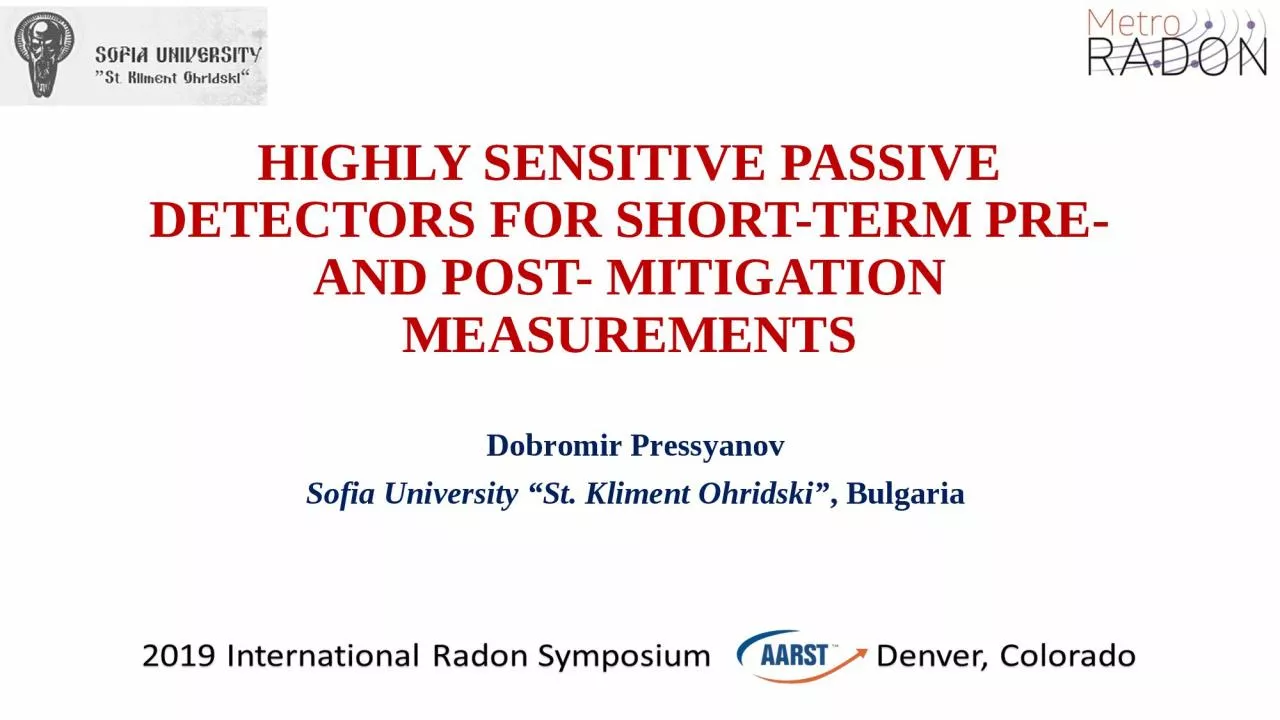

Dobromir Pressyanov Sofia University St Kliment Ohridski Bulgaria The focused challenge How to evaluate by shortterm eg one week integrated measurements at normal living conditions the radon reduction achieved after the mitigation work is completed ID: 1032860
Download Presentation The PPT/PDF document "HIGHLY SENSITIVE PASSIVE DETECTORS FOR S..." is the property of its rightful owner. Permission is granted to download and print the materials on this web site for personal, non-commercial use only, and to display it on your personal computer provided you do not modify the materials and that you retain all copyright notices contained in the materials. By downloading content from our website, you accept the terms of this agreement.
1. HIGHLY SENSITIVE PASSIVE DETECTORS FOR SHORT-TERM PRE- AND POST- MITIGATION MEASUREMENTSDobromir PressyanovSofia University “St. Kliment Ohridski”, Bulgaria
2. The focused challenge: How to evaluate by short-term (e.g. one week) integrated measurements at normal living conditions the radon reduction achieved after the mitigation work is completed? Measurements in many points needed in large buildingsMitigation efficiency is site-specific
3. A novel method for passive 222Rn measurements with sufficient sensitivity for that purpose is proposed:The method employs DVDs-based detectors of:low background (nB), large total detection area (S)increased calibration factor CF (CF=net track-density/222Rn exposure) In result the achievable MDAC (Minimum Detectable Activity Concentration) can be significantly lower than that of many passive 222Rn detectors.The approach is based on a modification of the CD/DVD method for radon measurements:
4. DVDs are used as large area track detectors. The sensitivity is amplified by using Makrofol N foils as radon absorbers/radiators:Surface with very low background: 1.1 0.3 cm-2. With thermal annealing can be reduced to 0.5 cm-2.
5. The concept to couple track detector with absorber of Makrofol N was proposed by Tommasino et al. (Radiat. Meas. 44 (2009) 719-723). In the present case the detectors are DVDs:Detector element of total area of 200 cm2
6. Etching of DVDs (infrastructure created within FP7- EURATOM Project DoReMi)
7. QA of the method: performance at the Public Health England (PHE-UK) 2017/2018 radon inter-comparison (Pressyanov D., Dimitrova I., Dimitrov D. IEEE-NSSS/MIC 2018)
8. Problem: Strong temperature dependence of the response (CF drops by factor of 2.6 from 5 0C to 35 0C)
9. However…polymer barriers against thoron and humidity (Ward W.J . et al., Rev. Sci. Instrum. 48 (1977) 1440-1441) incur reciprocal temperature dependence (Fleischer R. L. et al., Radiat. Meas. 32 (2000) 325-328)…,
10. Beyond state-of-the art: A module can be designed with R(T) that compensates that of CF(T) so that CFR const.:
11. Proof-of-the-concept: the “module” is a hermetic package of foil of 75 µm low density polyethylene with controlled V/S ratio ( 4 cm)
12. Results…NB: The module (package) is also an effective barrier against humidity and thoron interference!
13. Minimum detectable activity concentration after one week exposure (disk element surface area = 200 cm2)Not packed detectorsDetectors packed in the compensating module
14. The proposed concept for “compensating module” gives an opportunity to compensate the temperature dependence of many wide spread radon detectors which response decreases with increasing the temperature:Such detectors are e.g.:Detectors we present in this report;The most widely used track detectors: CR-39. These detectors show fading, and the (fading) decrease of the signal is larger at higher temperature (see e. g. Enomoto H. and Ishigure N., 2011; Caresana M. et al., Radiat. Meas. 45 (2010) 183–189);Detectors based on activated charcoal.
15. Conclusions:New design of passive detectors is proposed. Within one week exposure time quantitative measurements at 222Rn levels below 100 Bq m-3 can be made and MDAC below 20 Bq m-3 is achievable;A technical challenge was identified and a step beyond state-of-the art was proposed: a compensating module (patent pending) that provides technical solution capable to reduce or eliminate the temperature dependence (+ thoron interference + humidity influence) on the detectors described in this report, as well as on many other kinds of radon detectors.
16. Acknowledgement:This research is supported by the European Metrology Programme for Innovation and Research (EMPIR), JRP-Contract 16ENV10 MetroRADON (http://www.euramet.org). The EMPIR initiative is co-funded by the European Union’s Horizon 2020 research and innovation progamme and the EMPIR Participating States. I am grateful to Dr. Luigi Tommasino for providing high quality Makrofol N foils and to Mr. Dimitar Dimitrov for the technical assistance in the laboratory work.
17. Thank you!